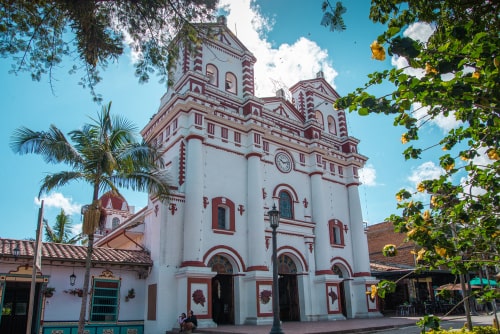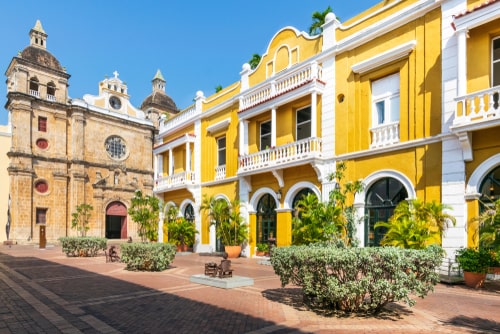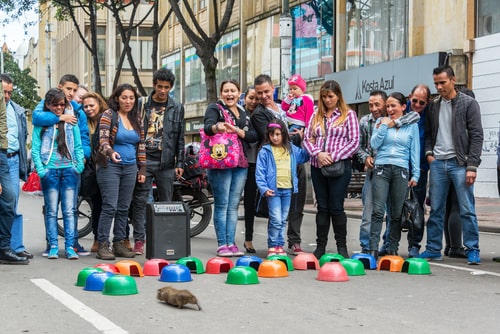Last updated on January 22nd, 2022
Cultural facts
56. Colombia is comprised of many regional cultures. Many of the indigenous groups of Colombia have embraced the Spanish cultural influences.
57. The architecture of the nation reflects Spanish colonial origins from the seventeenth century. There is evidence of Castilian and Moorish architecture in many of the cities in the region.
58. Colombia is considered to be a hierarchical society and people earn respect due to their position and their age.

59. The details in the many churches in the country reflect the Medieval and Renaissance eras in Spain.
60. It’s a big deal when a girl turns 15 in Colombia. But for a boy, it’s a regular birthday. There’s also a name for the special occasion, “La Quinceañera,” and the party that follows is named “Fiesta de Quince.”
61. Here are some gifting manners in Colombia: For a casual visit, bring a fruit or chocolate. For something elegant, bring imported alcohol. And for a girl’s 15th birthday, only gold.
62. In Colombian culture, flowers as a gift should only be sent in advance (roses are well liked), while making sure not to include lilies and marigolds, no matter how much of a discount you get. They are only reserved for funerals.
63. In Colombia, eyes are everything. Real Colombian men look deep into the eyes while shaking hands.
64. Upon meeting and departing it is considered to be courteous to shake both hands. A man should also wait for a woman to extend her hand.
65. Arranged marriages are no longer common in Colombia but residents are encouraged to marry within their class. Men and women are free to date whomever they wish but they need to have a chaperone (a person who accompanies and looks after another person or group of people.)

66. Most couples date for at least a year before getting married. Most couples are married in the Catholic Church.
67. Most domestic units consist of a mother, a father, and their children. Upper-class families tend to have many children.
68. In Colombian households, the father is typically the head of the household and the women raise and educate their children as well as take care of all the homemaking responsibilities.
69. Lower and middle-class wives normally have to work in the city or in the fields.
70. Ninety-five percent of the Colombian population are members of the Roman Catholic faith. Over 85 percent of urban Catholics attend mass regularly.
71. Art is a very large part of the Colombian culture. Many foundations and private individuals are strong supporters of Colombian art.
72. Colombia began to develop literacy after the Spanish arrived and its literature is still a strong influence.
73. Natives of the Andes created very detailed and intricate artwork over 2,000 years ago. After becoming colonized, native influences were replaced by European styles.
74. Colombia has a very diverse music scene. Vallenato is a type of Colombian dance and style of music that originated on the Atlantic coast.
75. Building relationships is very important in Columbia.
76. Most Colombians have a maternal and paternal surname and both are typically used. It’s important to refer to people by the correct title and surname so as not to come across as rude.
77. After friendships become more established greetings become warmer. Women will kiss on the right cheek and men will embrace each other and pat each other on the shoulder to show affection.

78. Parks are pretty much limited to only the larger towns and cities that were originally founded by the Spanish. Many people gather in these parks to engage in visiting, and other activities and benches are placed close together to encourage socializing.
79. It is quite common for children to live at home until they are ready to marry. The elders are respected for their life experience and age.
80. The family is always the very center of the social structure of Colombian culture.
Food culture in Colombia
81. Bandeja Paisa, the de facto national meal of Colombia, is not only a meal but a mini representation of the country itself.

82. Most of the families considered to be of middle-class eat meals that reflect Spanish and indigenous traditions. A day normally consists of a light breakfast, a bigger midday lunch, and a lighter meal in the early evening.
83. Dinner for the middle-class normally includes fresh fruit, a main dish with fish or meat with rice or potatoes, and a homemade soup.
84. Specialty dishes are eaten at holidays and a dish associated with the capital is known as ajiaco which is a special stew.
85. Lower income families eat more carbohydrates that end in a sweet dessert made from panela which is a type of brown sugar.
A Capital in a Valley- Bogota
The capital city of Colombia, Bogota is found in the central region of the country. It nestles in the middle of a mountain range in one of the valleys of the Andean Mountains. With an altitude of about 2,600 m above sea level, Bogota is quite cold especially in the morning. Temperatures can hit a freezing point.
Eagle: The Official Emblem of Bogota
The imperial symbol of Bogota is an Eagle that was issued by Charles V in December 1548. Each of the claws holds two red pomegranates and symbols of the New Kingdom of Granada. It served the kingdom until independence. Later, Bogota adopted it as the official arms in 1932.
World’s Capital of Salsa
In southern Colombia, about 45-minute flight from Bogota is the city of Cali. Party lovers gather here to dance salsa with some of the most famous dancers. Apart from being an industrial area, Cali offers a buzzing nightlife and plenty of eateries. Most fun activities happen in Juanchito District from the evening as temperatures cool down.

The White City of Colombia
Popayan is the best place to admire buildings from the 17th and 18th Centuries. The beautiful city, famed for a holy week of celebrations is packed with chalk white houses and churches. The holy week is the second biggest event in the world after Spain and Seville. Popayan is also renowned as the first gastronomy city and recognized by UNESCO for a plethora of cuisines representing Colombian culture.
Whites and Blacks Carnival
In the southern of Colombia, about two hours from the Ecuador border is a famous city of Pasto. It is well known for the ‘Carnival de Blancos y Negros’ that happens every January on date 5 and 6. The carnival dates back to the Spanish rule during which slaves joined their masters in festivities but with black painted faces.
City of Eternal Spring
Medellin, the second biggest city of Colombia has excellent weather. Hence the name ‘City of Eternal Spring.’ It attracts iconic bullfighters, beauty pageants, and craft fairs. It is also the only place you will find metro transportation. Flowers festivals are held in Medellin every August.
The Most Visited City- Cartagena
Situated in the Caribbean Coast, Cartagena is a touristy spot and a fascinating colonial city in Latin America. Its colonial architecture, picturesque plaza, fortress, and walls are top eye catchers. Other landmarks include Castillo de San Felipe, The Clock Tower, Convento de la Popa, Palacio de la Inquisicion, and Plaza de la Aduana.
The Oldest Surviving City of South America
Santa Marta is the city where Simon Bolívar, the American liberator died in 1830. Many historical places are found here e.g. Quinta de San Pedro and la Catedral de Santa Marta. The best beaches are in Santa Marta.
A City Founded by Muisca
Before the Spanish rule arrived, Bogota, the capital of Colombia was founded by the Muisca community. They created a settlement that was then referred to as Bacata which means ‘The Lady of the Andes’ in Chibcha language. When the Spanish colonizers came, the area developed into the capital of the Empire and a center for Viceroyalty of New Granada.
A Treasure Trove for Delicacies
Whether it is the ajiaco from Bogotá or Antioquia’s bandeja paisa, Columbian gastronomy offers delicious tidbits. Breakfast, the king of meals in Colombia, is filled with hearty platefuls like bandeja. This is a mixture of pork rinds, steak, ground beef, sausages fried eggs and arepa. Tinto is a common coffee variety in the cities.
Cucuta: The Contraband City
Cucuta has had a long history of contraband smuggling that is a direct outcome of the policies placed by Venezuela. The Venezuelan government tried to curb poverty only to feed profits to smugglers in Cucucta. Subsidized prices ought to give access to essential goods while protecting consumers from runaway inflation. Instead, they create discrepancies in prices with the free market neighbor in Venezuela. As a result, smugglers take advantage of the economic incentive.

Door Knockers With Colonial Status
In Cartagena, there are striking knockers on wooden doors that carry the significant social status of the colonial period. The historic walled city is filled with animal-shaped door knockers. Those that bear fish shape mark the houses of sailors and sea merchants. Lion knockers are for soldiers in the military department. Then lizard-shaped knockers symbolize aristocracy.

The Pretty City/ City of Parks- Bucaramanga
The pretty city of Colombia is the center of the Santander department. People love Bucaramanga for its beautiful gardens, parks, and pleasant weather. One of the most popular tourist activities in the city is paragliding.
River of the Axe- Riohacha
Hailed as one of the best places to live, Riohacha or Rio de la Hacha is the capital of La Guajira. It is situated alongside the Caribbean Sea and by the river of Rancheria. The name of the city originated from a local legend that was known as the legend of the axe.
Colombia – country at a glance
| Independence | 20 July 1810 (from Spain) |
|---|---|
| Capital City | Bogotá, D.C (4°35′N 74°4′W) |
| Largest City | Bogotá, D.C (4°35′N 74°4′W) |
| Total area | 1,138,910 sq km |
| Population | 49,588,357 (2024 est.) |
| Population growth rate | 0.48% (2024 est.) |
| Literacy rate (total population) | 95.6% (2020 est.) |
| Demonym | Colombian |
| Official Language | Spanish |
| Government type | presidential republic |
| President | Gustavo Petro |
| Vice President | Francia Márquez |
| Borders | Brazil, Ecuador, Panama, Peru, and Venezuela. |
| Currency | Peso (COP) |
| Religion | Catholicism |
| Life expectancy at birth | 74.9 years (2024 est.) Life expectancy at birth indicates the number of years a newborn infant would live if prevailing patterns of mortality at the time of its birth were to stay the same throughout its life. |
| Suffrage | 18 years of age; universal |
| National anthem | "Himno Nacional de la Republica de Colombia" (National Anthem of the Republic of Colombia) |
| National symbol | Andean condor |
| National colors | yellow, blue, red |
| Climate | tropical along coast and eastern plains; cooler in highlands |
| Terrain | flat coastal lowlands, central highlands, high Andes Mountains, eastern lowland plains (Llanos) |
| Mean elevation | 593 m |
| Lowest point | Pacific Ocean 0 m |
| Highest point | Pico Cristobal Colon 5,730 m |
| Natural resources | petroleum, natural gas, coal, iron ore, nickel, gold, copper, emeralds, hydropower |
| Agricultural land | 37.5% |
| Birth rate | 14.9 births/1,000 population (2024 est.) |
| Death rate | 8 deaths/1,000 population (2024 est.) |
| Sex ratio | 0.95 male(s)/female (2024 est.) |
| Industries | textiles, food processing, oil, clothing and footwear, beverages, chemicals, cement; gold, coal, emeralds |
| Exports | $67.762 billion (2023 est.)petroleum, coal, emeralds, coffee, nickel, cut flowers, bananas, apparel |
| Imports | $75.983 billion (2023 est.) industrial equipment, transportation equipment, consumer goods, chemicals, paper products, fuels, electricity |
| GDP - per capita (PPP) | $18,800 (2023 est.) |
| Time Zone | COT (UTC−5b) |
| Internet country code | .co |
| Calling Code | +57 |
| Drives on the | Right |
| Table last updated | October 22, 2024 |
